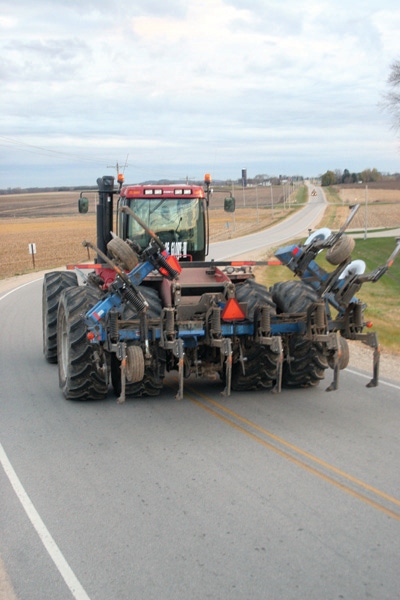April 15, 2011

The tremendous growth in farm assets may have some farmers exposed to an increased risk — not enough insurance to cover losses.
“Producers are sitting on more valuable assets, and from an industry standpoint we are seeing a more litigious atmosphere,” says Craig Conroy, supervisor of the farm underwriting department, Country Financial. “Much of our discussions center on ensuring our customers not only have the right coverage, but in the amounts that will protect their assets.”
Think about the assets on your farm and the last time you reviewed personal property and liability insurance. What were corn and soybean prices? And how much did it cost to put up that grain bin? If you haven’t updated your policy in the past year, your coverage may be insufficient.
“Dramatic price increases in commodity prices as well as things like machinery and steel have put many policies out of whack with what is needed today,” says Deb Etheridge, vice president of insurance, Water Street Solutions. “Proper risk management means having insurance in place that properly covers the value of the farm’s assets. And when we are talking about farmland values and commodity prices at current levels, all producers need to make sure that they have the right policies in place to cover their needs.”
Policies
Insurance policies vary according to individual operations, and each farmer should make sure his/her own policy covers current activities of the farm and provides adequate coverage for any losses related to those activities.
“Some insurance policies may exclude custom work,” says Philip Harris, professor of agriculture and applied economics, University of Wisconsin–Madison/Extension. “If you decide one spring to do some custom work, you need to ensure that your current policy has that work written in with a rider, or you write a new policy. You don’t want to find out after an accident or loss that you may not be covered.”
Another example of having the right coverage comes in family partnerships. For example, if a father and son are farming together, they may have insurance for the partnership. But any machinery owned outside that partnership also must be covered. “If Dad is driving down the road with a combine he owns outside of the insured partnership and has an accident, the partnership insurance may not cover the loss,” Etheridge says. “It is critical that not only the right policies are written, but that they are written for the correct entities engaged in the operation.”
A producer can be exposed to potential loss in thousands of ways. “The amount of coverage necessarily varies by producer and the activities they are involved in,” says Gary Hachfeld, extension educator in agricultural business management, University of Minnesota.
Start with an evaluation
The first step to developing a comprehensive insurance coverage plan is to take an honest evaluation of the current farming operation. “That system’s check is probably the most critical part of the process,” Etheridge says. “Step back and look at your operation like you were looking at it for the first time. There are parts of every farming operation that you see every day and may not realize how it could impact your insurance coverage options.”
Think of it as an exposure check. Do you drive machinery on busy highways? Do you truck grain long distances? Do you provide custom work? Do you have customers who visit your farm on a regular basis? “Look at what you have and what you want to protect,” Conroy says. “The amount of exposure that you have dictates the amount of insurance you may need.”
And while property and liability insurance does have a cost associated with it, experts say it’s important to first evaluate what you want to protect before looking at costs. “Costs are part of the equation, but you need to know what assets you have and what you need to adequately protect those assets first,” Etheridge says.
“Insurance is all about mitigating risks,” she adds. “We use crop insurance and hedges for risk management to protect the value of our crops. Other kinds of insurance help us protect the rest of the operation.”
Open disclosure
All farm activities should be discussed with an agent to ensure proper insurance coverage is developed and written. “Writing a correct policy that provides the necessary coverage is imperative,” Harris says. “That’s not the time to hide the activities of the farm to keep the premium lower. Be open and honest with agents so they can write the correct policy.”
And once a policy is written, it is imperative that those policies are kept up to date. “Insurance policies are fluid,” Harris says. “Just as crop mixes change on the farm, the value and functions of every operation changes over time. Policies need to be updated to reflect those changes.”
One example is an umbrella insurance coverage for the farm. “One common value on an umbrella policy was $1 million,” Etheridge says. “Today, those policies could easily be $3 million, $5 million or more to adequately provide the same loss coverage.”
Policies should be reviewed at least once a year. “That’s the minimum we suggest,” Etheridge says. “But for some producers a review might be needed quarterly.”
The bottom line is that any time a change in your operation occurs, you should review your insurance coverage to be sure you are adequately protected. As operations get bigger, their structures and entities often change or are modified. “That’s a perfect time to review your policies,” Conroy says. “Insurance should be part of your regular business plan and reviewed.”
“Farmers are so hard-working and often spend a lifetime building their farming operation,” Etheridge says. “Unfortunately, all those assets can be lost if the operation is not adequately insured.”
It’s more than just protecting against a loss. “Insurance is about protecting what you have,” Etheridge says. “And protecting what you want to pass along to future generations.”
About the Author(s)
You May Also Like






